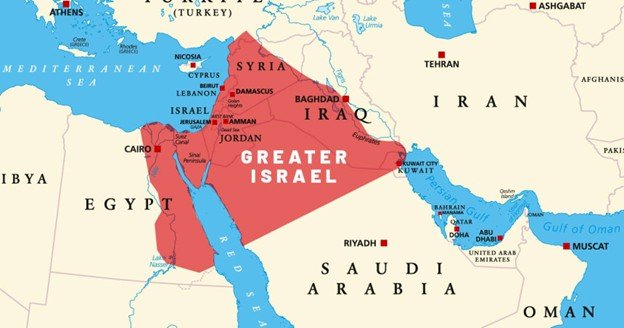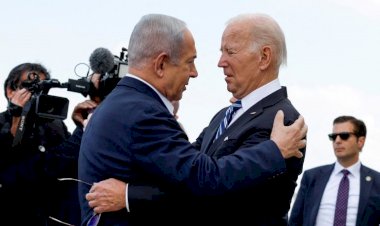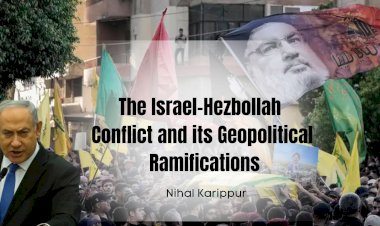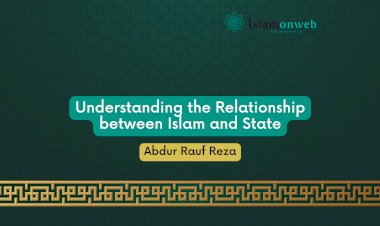The ‘Greater Israel’ Doctrine Goes Mainstream in Netanyahu’s Israel
For decades, figures within Israel’s religious Zionist movement and far-right political circles have openly expressed their desire to realise the dream of a “Greater Israel” and the so-called “Promised Land,” especially since the outbreak of the ongoing war of extermination in Gaza. Defenders of Israel used to argue that such statements—coming from ministers or Knesset members of this current—did not represent the official position of the Israeli government and did not signal a shift in the state’s strategic vision towards its Arab neighbourhood.
That argument is now harder to sustain. In a recent interview with Israel’s i24 News, Prime Minister Benjamin Netanyahu himself voiced support for the idea, marking a significant departure from past official rhetoric. For the first time, Israel’s head of government has publicly embraced the expansionist vision rooted in religious-biblical narratives about the Promised Land, the coming of the Messiah, the “end of days,” and a thousand-year utopia, concepts long championed by religious Zionist hardliners.
In the interview, Netanyahu declared that he feels he is on a “historic and spiritual mission” linked to generations of Jews through the ages, saying he was acting with a mandate from “generations of Jews.” When asked whether this included the vision of a “Greater Israel,” he replied confidently in the affirmative. Israel’s Zman Yisrael ran the headline: “Netanyahu says he is on a historic and spiritual mission, endorses Greater Israel vision.”
According to the interview, Netanyahu expressed a deep connection to the concept of “Greater Israel,” encompassing territories that under the Oslo Accords were meant to form a future Palestinian state, as well as parts of Jordan and Egypt. The interviewer, Sharon Gal—a former Knesset member for the right-wing Yisrael Beiteinu party, presented Netanyahu with a symbolic map of the biblical “Promised Land” and asked if he endorsed it. Netanyahu replied: “Very much so.”
A Biblical Project Threatening Eight Arab States
Netanyahu’s statement on Wednesday effectively revived a long-standing biblical-Talmudic project used by the Israeli right to justify expansionist policies. This vision was dramatically displayed when he presented a “Greater Israel” map at the UN General Assembly on 22 September 2023, and earlier when he vowed to lead Israel into what he called its “centennial era.”
The “Greater Israel” project is championed by Israel’s hard-line right, now in coalition with Netanyahu. It was notably advanced in 2016 by Bezalel Smotrich—then a Knesset member and now finance minister—who declared in a televised interview that Israel’s borders should extend to include Damascus, along with territory from six other Arab countries: Syria, Lebanon, Jordan, Iraq, part of Egypt, and part of Saudi Arabia, fulfilling the Zionist dream of a land stretching “from the Nile to the Euphrates.”
In March 2023, Smotrich reiterated this vision during a speech in Paris, standing on a stage adorned with a map depicting “the Land of Israel” as encompassing both historic Palestine and Jordan.
The Likud Party has promoted the “Greater Israel” concept since coming to power under Menachem Begin in 1977, transforming it into a political programme built on ideas that pre-date the state itself. This included adopting the biblical terminology of “Judea and Samaria” for the West Bank and actively promoting Jewish settlement expansion.
The idea, however, predates the state of Israel itself: in 1904, Zionist founder Theodor Herzl described a state extending from the Nile in Egypt to the Euphrates in Syria and Iraq. Extremist militias like the Irgun, active during the British Mandate, also called for both historic Palestine and Jordan to be Jewish.
Supporters of this ideology cite passages from the Book of Genesis, along with voices within the Zionist movement calling for Israel’s borders to be expanded to include large parts of the Middle East. These religious doctrines claim that the Promised Land stretches from the Nile River in Egypt to the Euphrates River in Syria and Iraq.
The Israeli “Torah and Land Institute” states on its website that “Greater Israel extends from the Euphrates River in the east to the Nile River in the south.” This mirrors the words of Theodor Herzl, founder of the Zionist movement, who outlined this expansionist vision in 1904, a vision that has been preserved and promoted by Zionist leaders for more than 120 years.
Similarly, the extremist Zionist militia Irgun—active during the British Mandate in Palestine (1922–1948) and later incorporated into the Israeli army—called for both historic Palestine and Jordan to be a Jewish state.
The map often associated with this project encompasses: all of historic Palestine (27,027 km²), Lebanon (10,452 km²), Jordan (89,213 km²), over 70% of Syria (from its total of 185,180 km²), half of Iraq (438,317 km²), roughly one-third of Saudi Arabia (2,149,690 km²), a quarter of Egypt (around 1 million km²), and part of Kuwait (17,818 km²).
Settlements: From Vision to Concrete Action
The “Greater Israel” rhetoric is not confined to speeches and maps, it is being entrenched on the ground. On Thursday, Israel announced the expansion of the Ma’ale Adumim settlement, a project seen by many as the formal death blow to the decades-old notion of a Palestinian state. Finance Minister Bezalel Smotrich declared the launch of a long-delayed plan to connect Ma’ale Adumim to occupied Jerusalem, with the full backing of Netanyahu.
The project involves the confiscation of thousands of dunams of land and the investment of billions of shekels, aiming to bring one million settlers into the West Bank. According to journalist Montaser Nassar, it entails the construction of more than 3,400 new housing units, along with further expansion in Ariel settlement. This would effectively sever the northern West Bank from the south and completely isolate it from Jerusalem, solidifying the geographic fragmentation that undermines any future Palestinian state.
Turning this biblical creed into a political programme with concrete implementation is perhaps the most dangerous element of Netanyahu’s current agenda, especially amid the ongoing Israeli war of extermination in Gaza since October 7, the targeting of Syrian military power after the collapse of its regime in December 2024, the crises plaguing Syria, and the war in Lebanon.
Arab Official Reactions – Strong Words, Little Else
In the wake of Netanyahu’s declaration, Arab capitals responded with what has become a well-rehearsed ritual: swift statements, stern language, and little to show beyond that.
Jordan condemned the remarks as a “serious and provocative escalation” and a “threat to national sovereignty,” warning of violations of international law and the UN Charter. The words were sharp, but no tangible measures followed.
Egypt called for “clarifications” from Tel Aviv—despite the fact that Netanyahu’s map of Greater Israel, covering swathes of Egyptian territory, left little room for misunderstanding. Cairo reiterated its commitment to peace, the 1967 borders, and ending the war on Gaza, while refraining from mentioning any concrete steps to counter the plan.
Saudi Arabia issued a “strong condemnation,” rejecting expansionist ambitions and reaffirming the Palestinian right to statehood—an oft-repeated position that remains confined to diplomatic communiqués.
The Arab League labelled the statement a “violation of sovereignty” and urged the UN Security Council to act, a call that echoed many similar appeals over the decades, almost all unanswered.
The Gulf Cooperation Council followed suit, describing Netanyahu’s words as a “blatant violation of international law” and a “direct threat” to stability—an assessment delivered with no accompanying strategy to confront it.
While Arab leaders spoke, Israel moved ahead on the ground. The announcement of a massive expansion in Ma’ale Adumim settlement, backed by Netanyahu himself, signalled the continuing erasure of the two-state formula. For Palestinians in Gaza and the West Bank, the reality was clear: Israel’s territorial ambitions were advancing in bricks and concrete, while Arab responses remained locked in the realm of rhetoric.
Disclaimer
The views expressed in this article are the author’s own and do not necessarily mirror Islamonweb’s editorial stance.
























Leave A Comment